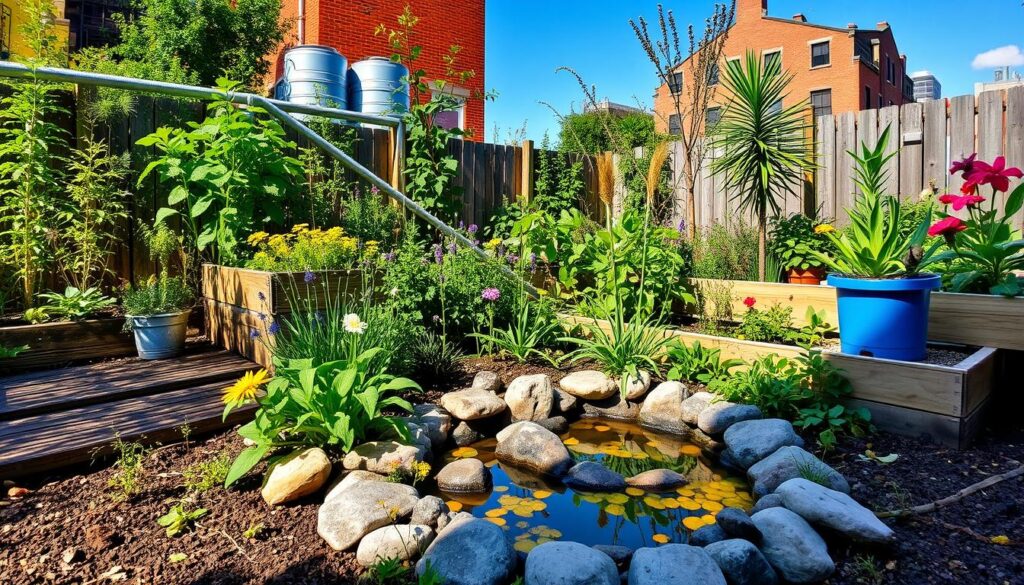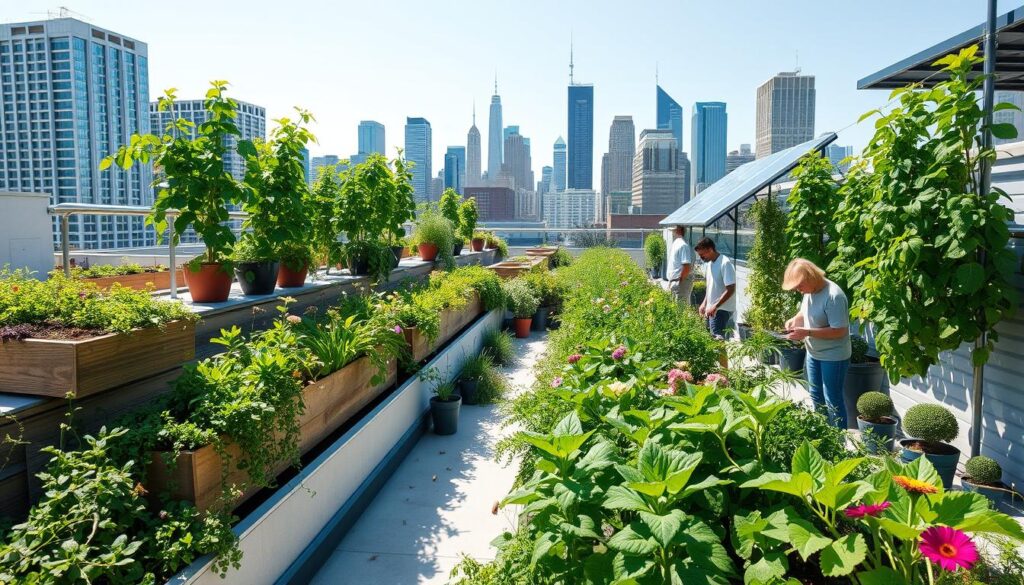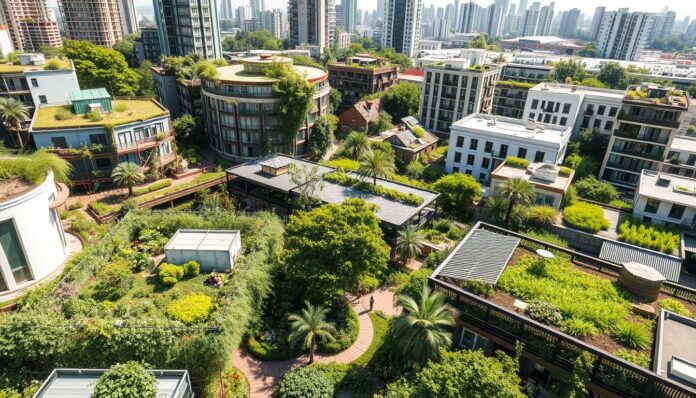Permaculture planning is key for green cities. It uses community design to make cities eco-friendly. The term “permaculture” was coined in the 1970s by David Holmgren and Bill Mollison. It aims to blend homes, plants, animals, and water for productive communities.
By using permaculture in cities, we can cut down on waste. This approach encourages us to use resources wisely. It’s not just for homes but for whole communities too.
Permaculture focuses on saving energy and treating wastewater. It’s based on ecology, which is growing in urban areas.
More people live in cities now, with over 50% urban dwellers. This number is set to rise to two-thirds by 2050. Cities produce 80% of greenhouse gases, making green planning crucial.
Permaculture offers a way to design cities sustainably. It’s about working together for a greener future.
Key Takeaways
- Permaculture municipal planning is essential for sustainable urban development
- Community-based design is crucial for creating environmentally conscious cities
- Permaculture principles can reduce dependence on consumerism and promote sustainable consumption patterns
- Energy-efficient buildings and wastewater treatment are key components of permaculture design
- Integrating ecological principles into urban planning is vital for reducing greenhouse gas emissions
- Permaculture municipal planning offers a framework for community-based design and sustainable urban development
Understanding Urban Permaculture Utilities
Urban permaculture utilities use permaculture ideas to improve urban areas. This includes managing water, producing energy, and handling waste. These are key for making cities sustainable. By using ecological city planning and green infrastructure, cities can be more eco-friendly.
Permaculture is about making systems that are sustainable and grow. In cities, this means using green infrastructure to lessen environmental harm. Regenerative urban design helps create ecosystems that can take care of themselves.
Projects like the City Repair Project in Portland, OR, and Village Homes in Davis, CA, show what’s possible. They use permaculture in public areas and buildings. This makes cities more sustainable and strong.
| Project | Location | Description |
|---|---|---|
| City Repair Project | Portland, OR | Permaculture in public spaces, contributing to community resilience |
| Village Homes | Davis, CA | Multi-unit development leveraging permaculture principles |
By using permaculture, cities can make their utilities better. This means less harm to the environment, stronger communities, and better lives for city folks.
The Role of Water Management in Urban Permaculture
Effective water management is key for making cities more resilient to climate change. It’s also essential in urban permaculture. Techniques like rainwater harvesting and greywater recycling help save a lot of water. For example, rainwater systems can meet 50%-100% of a home’s irrigation needs. Greywater recycling can cut down fresh water use by about 30% for homes.
Using these water-saving methods helps cities grow their own food. This makes cities more self-sufficient. Some important water-saving techniques include:
- Drip irrigation systems, which can use 30-50% less water compared to traditional irrigation methods
- Xeriscaping, which can reduce landscape water requirements by 50% to 75% compared to conventional landscaping
- Regular inspections and repairs of leaks, which can save up to 20% of the water supply that is usually wasted

By using these methods, cities can use less water. This reduces their environmental impact and makes them more resilient to climate change. This helps create sustainable cities that can grow their own food. It makes cities better places to live.
| Water Conservation Method | Water Savings |
|---|---|
| Rainwater Harvesting | Up to 50%-100% of household irrigation needs |
| Greywater Recycling | Approximately 30% of fresh water demand |
| Drip Irrigation Systems | 30-50% less water compared to traditional irrigation methods |
Energy Solutions for Urban Permaculture
More than 55% of the world’s population lives in cities now. This makes finding renewable energy in urban permaculture very important. Solar and wind power are key to cutting down urban carbon footprints and supporting sustainable growth. They help cities use less fossil fuel and fight climate change.
Good land use planning is vital in urban permaculture. It helps use resources well and cuts down waste. Cities can lessen their environmental harm and build better, greener places. For example, solar energy integration and wind energy opportunities are great for urban areas. They can be part of community energy projects.
Community energy projects are a great way to boost renewable energy and smart land use in cities. They involve local governments, businesses, and groups working together. This can lower energy bills and encourage caring for the environment. Together, cities can build a greener future and support renewable energy in urban permaculture.
Urban Food Production and Its Utilities
Urban food production is key in permaculture. It focuses on sustainable and community-based food systems. This means using community-based design and green infrastructure planning to make food systems productive and efficient. By doing this, cities can lessen their need for industrial agriculture and boost local food production.
Community gardens and vertical farming are great examples of urban food production. These methods not only give fresh food to local areas but also bring people together. For example, the Beacon Food Forest in Seattle has shared garden plots. It uses permaculture to make the most of space.

By using urban agriculture and community-based design, cities can build strong and lasting food systems. This is done through green infrastructure planning and new ways of growing food in the city. As permaculture grows, it’s crucial to see how important urban food production is. It can change how we view food systems.
Waste Management Strategies in Permaculture
Effective waste management is key in urban permaculture. It focuses on reducing, recycling, and composting to cut down waste. Composting can turn a lot of food scraps into useful resources, cutting down household waste by up to 30%. This is a big part of keeping waste sustainable.
Recycling programs are also vital in urban permaculture. They let us reuse materials that would be thrown away. By using waste reduction and recycling, we can lessen our environmental harm. This helps make the future more sustainable.
Some ways to reduce waste include:
- Composting food scraps and yard waste
- Joining community recycling programs
- Starting zero-waste projects at home and in the garden
By adopting these methods, we can help manage waste better. This reduces our environmental impact.
| Waste Reduction Strategy | Environmental Benefit |
|---|---|
| Composting | Reduces greenhouse gas emissions and creates nutrient-rich soil |
| Recycling | Conserves natural resources and reduces landfill waste |
| Zero-waste initiatives | Decreases waste generation and promotes sustainable consumption patterns |
The Importance of Soil Health in Urban Environments
Soil health is key for urban areas. Soil conservation and landscaping aim to boost soil quality and biodiversity. With 50% of people living in cities, good urban forestry is more crucial than ever.
Urban areas can lose up to 70% of their natural soil biodiversity. But, using permaculture can help. It increases organic matter, which can hold up to 40% more moisture. This helps ecosystem services and fights climate change.
Improving soil health in cities involves several steps:
- Soil remediation techniques, such as composting and mulching
- Urban landscaping for soil improvement, including native plants
- Reducing hard surfaces to protect natural water cycles and soil
By focusing on soil health, cities can offer many benefits. They can improve air and water quality and boost biodiversity. This makes cities better for both the environment and people living there.
| Strategy | Benefits |
|---|---|
| Soil remediation techniques | Improved soil health, increased organic matter |
| Urban landscaping for soil improvement | Enhanced biodiversity, reduced soil erosion |
| Reducing impervious surfaces | Improved natural water cycles, reduced soil erosion |
Biodiversity: A Key Element in Urban Permaculture
Urban biodiversity is key in urban permaculture. It helps restore ecosystems and protect wildlife. By making urban areas into wildlife habitats, using native plants, and creating pollinator gardens, we can boost biodiversity. This makes cities not just look good but also helps the environment.
Some important ways to increase urban biodiversity include:
- Creating wildlife habitats, such as green roofs and community gardens
- Using native plants, which need less care and help local ecosystems
- Setting up pollinator gardens, which keep pollinators healthy
These methods can be used in many urban places, from homes to parks. They help make cities healthier and more sustainable. This is vital for keeping ecosystems balanced and supporting biodiversity in cities.

The International Union for the Conservation of Nature says agriculture is the biggest threat to biodiversity. But, by using permaculture and boosting urban biodiversity, we can lessen this harm. This way, we help make food systems more sustainable. It also improves the health and strength of urban ecosystems.
| Strategy | Benefits |
|---|---|
| Creating wildlife habitats | Enhances ecosystem restoration and wildlife conservation |
| Utilizing native plants | Supports local ecosystems and reduces maintenance |
| Establishing pollinator gardens | Maintains healthy pollinator populations and supports food production |
Transportation Utilities in Urban Permaculture
Urban permaculture focuses on designing better ways to get around cities. It aims to cut down on car use and boost green travel options. This helps make cities more sustainable and easier to get around.
By adding green infrastructure like bike paths and walkways, cities become better places to live. They become greener and more friendly to the environment.
Here are some ways to make cities greener:
- Creating bike-share programs and bike lanes
- Improving public transit like buses and trains
- Setting up car-free areas for people to enjoy
These steps help cities be kinder to the planet. They also make the air cleaner and life better for everyone.
Community Engagement in Urban Permaculture
Getting people involved is key for urban permaculture to work. By working with locals and groups, we can build stronger communities. For example, in Portland, over 40 groups are learning about permaculture. They focus on building community and designing green spaces.
Projects that involve the community can make our neighborhoods better. They help us connect and make our voices heard. Through workshops and classes, we can create green solutions together.
Some big wins of community involvement in urban permaculture are:
- Stronger community bonds
- Greener spaces through teamwork
- More people taking part in planning
By focusing on community, urban permaculture can make our cities better. As cities grow, working together will become even more important.
| City | Community Engagement Initiatives | Outcomes |
|---|---|---|
| Portland | Permaculture training process, community workshops | Increased social cohesion, improved environmental sustainability |
| New York City | Community gardens, urban farming initiatives | Improved access to fresh produce, reduced greenhouse gas emissions |
Policy and Regulation for Sustainable Utilities
Effective urban policy is key to supporting sustainable development. It helps set up rules that encourage the use of renewable energy and reduce waste. This way, cities can lessen their environmental footprint and work towards a greener future.
Some important strategies for promoting sustainable development include:
- Implementing zoning regulations that accommodate urban agriculture and green spaces
- Creating incentives for developers to incorporate sustainable design principles into their projects
- Investing in public transportation and pedestrian-friendly infrastructure
Regulatory frameworks also play a big role in supporting sustainable development. They provide a structure for adopting sustainable practices. This includes rules on energy efficiency, water conservation, and waste reduction. Together, cities can build a sustainable future by using effective policies and frameworks.
Cities can create green belts or urban wild corridors to protect native plants and animals. They can also require developers to include plantable spaces in new projects. By planning ahead, cities can make their environment more sustainable and livable for everyone.
| Strategy | Benefits |
|---|---|
| Implementing zoning regulations for urban agriculture | Increased food security, reduced transportation emissions |
| Creating incentives for sustainable design | Reduced energy consumption, improved air quality |
| Investing in public transportation | Reduced traffic congestion, improved air quality |
Financial Models to Support Urban Permaculture
Starting urban permaculture projects needs creative financial plans. Sustainable financing like crowdfunding and community investments can help. The aim is to build a green economy that helps the planet and people.
Here are some ways to fund urban permaculture:
- Crowdfunding: lets people invest in local projects and support community growth.
- Community investments: gives money to local businesses and projects that support sustainability.
- Grants and subsidies: offers money for projects that follow urban permaculture’s principles.
These models help focus on community investment in urban growth. They make communities more sustainable and strong. By using these, urban permaculture can grow and help the green economy.
| Financial Model | Description |
|---|---|
| Crowdfunding | Allows individuals to invest in local projects |
| Community Investments | Provides funding for local businesses and initiatives |
| Grants and Subsidies | Offers financial support for sustainable development projects |
Future of Urban Permaculture
The future of urban permaculture looks bright, with innovation leading the way. It’s set to grow, helping more people and places. As cities expand, the need for sustainable urban development grows too. Urban permaculture is evolving, blending food, energy, and community.
Looking ahead, urban permaculture will focus on a few key areas:
- Scaling up successful models of urban permaculture to achieve broader impact
- Integrating urban permaculture with existing urban planning and development frameworks
- Supporting innovative urban permaculture projects and initiatives
By adopting urban permaculture, cities can become better places to live. As the world gets more urban, urban permaculture’s role will grow. It will drive innovation and progress.
Urban Permaculture Case Studies: Success Stories and Lessons Learned
Urban permaculture is a powerful tool for transforming cities into sustainable, thriving ecosystems. Through real-world examples, we can learn valuable lessons and gain insights into the best practices for urban permaculture.
One notable case study is the High Line in New York City. This former elevated rail line was transformed into a vibrant green space, showcasing the potential of urban permaculture. The High Line serves as a model for urban regeneration, demonstrating how abandoned spaces can be repurposed for the benefit of both the environment and the community.
Another successful urban permaculture project is the rooftop garden in Chicago. This innovative initiative turned unused rooftops into productive spaces, providing fresh produce to local residents. The rooftop garden not only promotes sustainable food systems but also enhances the aesthetic appeal of urban landscapes.
These urban permaculture case studies highlight the importance of community involvement and collaboration. By working together, individuals and organizations can create positive change and foster a sense of community. These success stories serve as inspiration for others to embark on their own urban permaculture projects.
Through these case studies, we can learn valuable lessons about the potential of urban permaculture. We can gain insights into the challenges faced and the innovative solutions implemented. By studying these success stories, we can adapt and apply these best practices to our own urban environments, contributing to a more sustainable and resilient future.
Urban Permaculture Case Studies Summary
| Case Study | Location | Key Features |
|---|---|---|
| High Line | New York City | Transformed abandoned rail line into a green space |
| Rooftop Garden | Chicago | Utilized unused rooftops for productive spaces |

